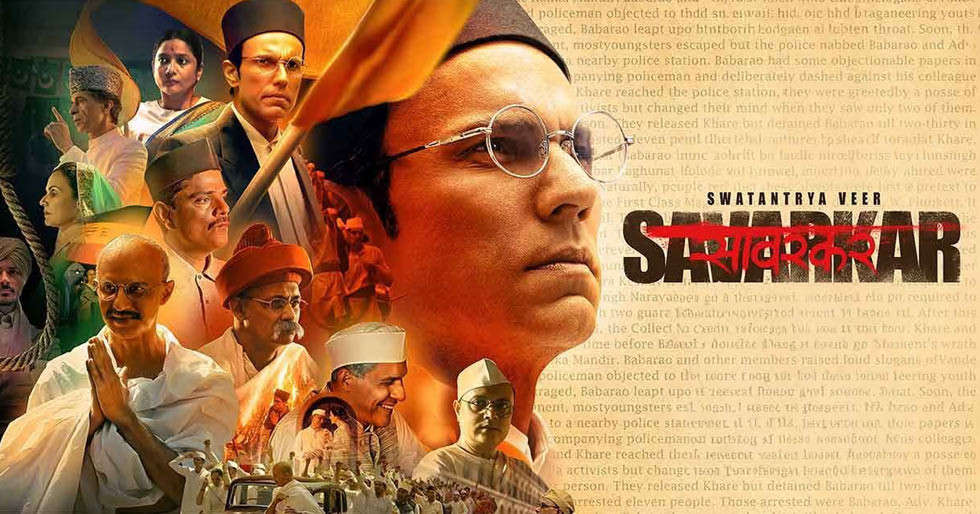
3.0/5
Swatantra Veer Savarkar is a biopic of Vinayak Damodar Savarkar. In debutant director Randeep Hooda’s vision, Savarkar has been set up as a mastermind of sorts who influenced the armed revolutionaries. Everyone from Madanlal Dhingra, to Khudiram Bose to even Bhagat Singh and Netaji Subhas Chandra Bose were seemingly shaped by Savarkar’s influence to become warriors for the motherland. The film features a scene in which Bhagat Singh meets Savarkar, an incident that doesn’t have any historical truth in it. It also states that Netaji Subhas Chandra Bose sought his guidance and that he helped Bose find footing in Germany. There is no evidence of this either and Netaji’s grandnephew Chandra Kumar Bose himself has time and again said that something like this never happened.
In the present narrative, Savarkar has been set up as a bigger and better leader than Mahatma Gandhi. He’s made out to be a person who made the British quake in their boots. While Gandhi comes across as a weak man, bent on British appeasement, Savarkar is shown as a decisive figure who would have won us independence in the 1910s itself if he had his way. The moral fortitude of the Mahatma, his policies of non-violence, and compassion even to one’s enemies, are laughed at in the film. What’s shocking is that it’s hinted that Congress might have had a hand in Gandhi’s assassination, which was carried out by a member of Hindu Mahasabha, Nathuram Godse, whom history tells us was close to Savarkar, the chief leader of the organisation. At this point you stop believing in the seriousness of the film.
Savarkar went to England to be a barrister and there, along with members of Free India Society, like P.M. Bapat, V.V.S. Aiyar, Madanlal Dhingra, and V.N. Chatterjee espoused hardline views opposing British Raj and even took to smuggling arms to India. After his arrest in London and his botched attempt at jumping ship off the coast of Marseilles, he was sent to Kaalapani prison in the Andamans in 1911, where he was sentenced to serve two life sentences. He repeatedly petitioned the British for his release, and was finally sent back to India in 1921, and was imprisoned at the Ratnagiri jail. Later, he was given a full pardon and got out of jail in 1924 on the condition that he’ll not be allowed to leave Ratnagiri and take part in politics, which he agreed to. He became a social reformer and rallied against the caste system. Ironically, someone who mocked Gandhi’s method of fasting to bring out reforms, himself fasted to death in 1966. A man believing in ahimsa met his end at the hands of violence while a man believing in violence sought non-violent means to end his life.
The film is shot in a linear progression and the director’s insistence on putting everything in the narrative begins to take its toll. At three hours, the film is too long and could have been done with some trimming. While the production design and costume design are spot on, the direction falters at times. There are too many close-ups, too many branches of the fourth wall. The whole thing feels like a play at times.
Amit Sial shines as Ganesh Damodar Savarkar, the elder brother who never got his due in the history. British actor Russell Geoffrey Banks is impressive as the jailor David Barry, who loved reigning atrocities at the prisoners. Ankita Lokhande plays the role of Yamunabai Savarkar, Savarkar’s wife, and doesn’t have much to do, as the focus is totally on the male protagonist. The film’s onus falls on Randeep Hooda. Leaving aside the faulty direction and the liberty taken with history, his commitment as an actor to his debut film as a director can’t be questioned. Randeep Hooda has given his all to the film. He reportedly lost some 30 kgs to get into the gaunt frame of Savarkar. He’s the very image of the fierce Hindutva crusader, eyes burning with the sacred light of his cause, blindingly convinced that his is only the right way. You get to see the controversial leader in the flesh through Hooda’s performance.
Watch the film for the masterclass in acting presented by Randeep Hooda, who needs to find a better hold over his skills as a director.
Trailer : Swatantra Veer Savarkar
Renuka Vyavahare, March 22, 2024, 2:01 PM IST
3.5/5
Story: Was Savarkar a devout patriot or a bomb golavala who incited violence? Accused and acquitted of multiple conspiracy theories which includes Gandhi’s assassination, the biopic takes a closer look at the fiery freedom fighter and his tumultuous life.
Review: Vinayak Damodar Savarkar aka Swatantrya Veer Savarkar has been a controversial figure in India’s freedom struggle, given his unequivocal allegiance to armed revolution, notwithstanding the consequences. The revolutionary endured years of torture in the cellular jail. He paid a hefty price for his ideology by being dragged in the centre of a political storm ever since.
Hailed by some for his bravery and humiliated by others for his mercy petitions to the British, the film makes him feel heard and seen. His formation of ‘Hindutva’ prioritised country over religion, condemned casteism, social hierarchy, superstition, and inequality. One man’s terrorist is another man’s freedom fighter. One man’s hero is another man’s villain. Every truth has two sides. Randeep Hooda’s biopic on Savarkar, doesn’t flinch while speaking its truth, hoping to reinstate the dignity and respect, that the writer-freedom fighter was stripped off over the years.
Spanning decades, right from pre to post independence, the film understands the key events of Savarkar’s life without rushing through it. Contribution of his family in the freedom struggle, formation of secret society Abhinav Bharat, activities at India House, belief in the teachings and mindset of Bal Gangadhar Tilak, differences with Gandhi and absolute hatred for slavery, injustice, and oppression, this one’s all encompassing. Given the sheer magnitude of the story, this was a tough one to crack but first-time director, Randeep Hooda, who also plays the titular role makes this a compelling watch.
Tense, engaging and unsettling, the film does more than presenting a recap of historical events. It delves into the psyche, morals, and implications of it all. Nothing is surface level. Each frame has a story to tell. Barring one song that plays in the background in the second half, no time is wasted in music to get the patriot in you going. The dialogues get your blood pumping. The film is technically sound and transportive. It doesn’t exploit or glorify Savarkar’s ordeal at the Kaalapani (solitary confinement) but weaponises it. Some scenes stay with you like the interactions between Gandhi and Savarkar. The clash of ideologies never led to disrespect.
What sticks out as a sore thumb in an otherwise well-made film is the blatant vilification of the Indian National Congress and Gandhi as a minority and British sympathiser. The film doesn’t propagate violence though. It wants you to merely acknowledge the sacrifices of armed revolutionaries which are often overlooked because ‘ahimsa’ paved the way to freedom.
Interestingly, Hooda’s massive physical transformation is just the tip of the iceberg. He presents Savarkar as both heroic, and helpless, and someone who fought till the end despite the inhuman atrocities inflicted upon him. While Gandhi was hailed as a Mahatma, Savarkar was compelled to wonder if the himsa (violence) he supported for justice and Swatantrata (freedom) led to sarvanash (destruction) instead. This one’s a polarising but powerful biopic that attempts to vindicate Savarkar. It tells his side of the story.
Source Powered by Yes Mom Hosting






